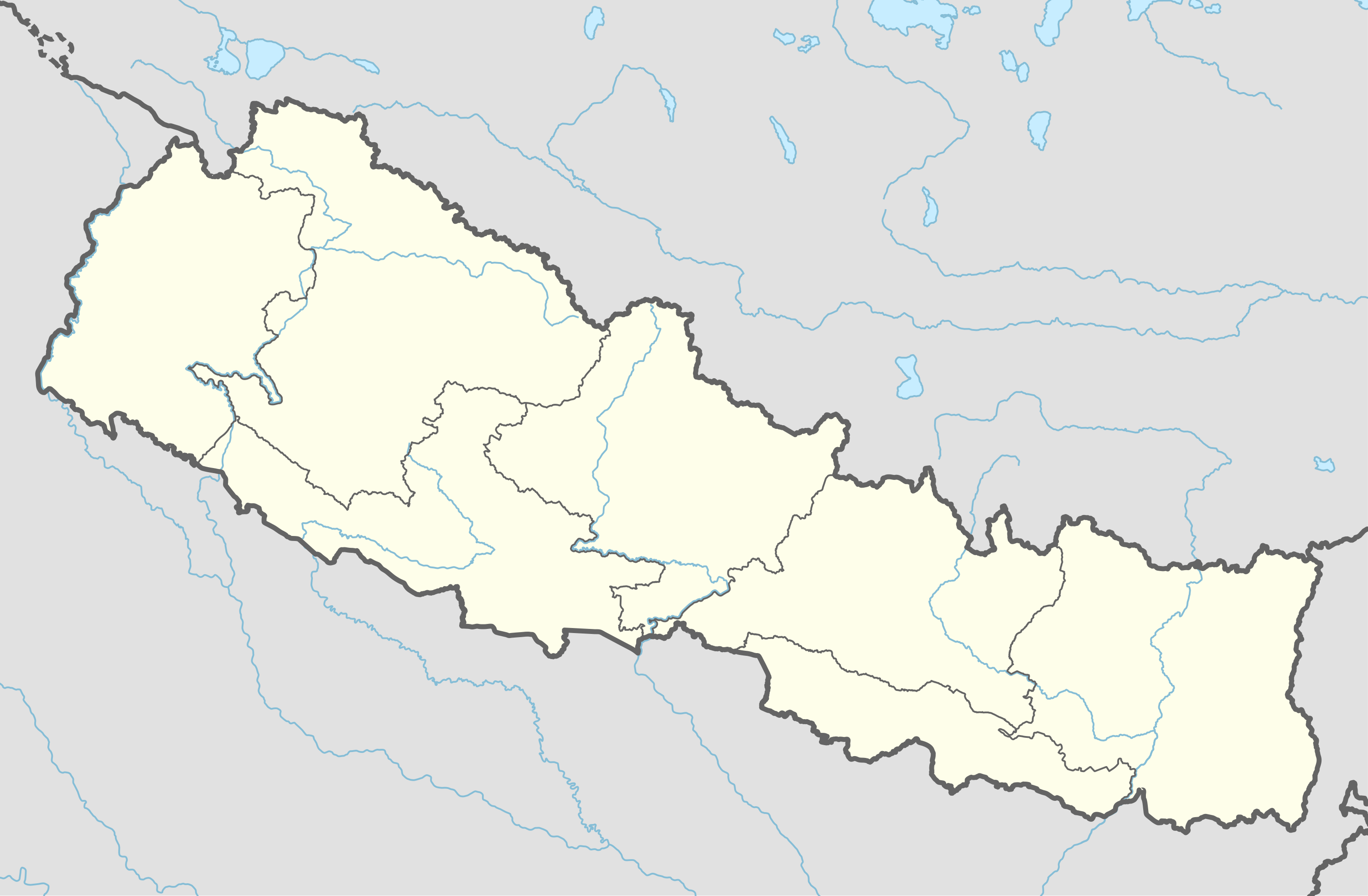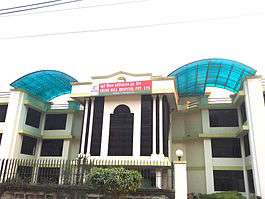Hetauda
| Hetauda हेटौंडा | |
|---|---|
| Sub-Metropolitan City | |
 Hetauda Location in Nepal | |
| Coordinates: 27°25′N 85°02′E / 27.417°N 85.033°ECoordinates: 27°25′N 85°02′E / 27.417°N 85.033°E | |
| Country | Nepal |
| Zone | Narayani Zone |
| District | Makwanpur District |
| Government | |
| • Type | Mayor–council |
| • Mayor | Hari Bahadur Mahat (NCP) |
| • Deputy Mayor | Mina Kumari Lama (NCP) |
| Area | |
| • Total | 261.59 km2 (101.00 sq mi) |
| Elevation | 345 m (1,132 ft) |
| Population (2015) | |
| • Total | 152,875 |
| • Density | 580/km2 (1,500/sq mi) |
| Time zone | UTC+5:45 (NST) |
| Post code | 44100, 44107 |
| Area code(s) | 057 |
| Website | www.hetaudamun.gov.np |
Hetauda (Nepali: हेटौडा) is a sub-metropolitan city in the Makwanpur District of Narayani Zone of southern Nepal. It is the administrative headquarters of the Makwanpur District, the headquarters of Nepal's Central Development Region, and the interim state capital of Province No. 3. It is one of the largest cities of Nepal. At the time of the 2015 Nepal census, it had a population of 153,875 people.[1]
Hetauda sub-metropolitan city is situated in the confluence of the two prominent national highways viz. Tribhuvan highway and Mahendra highway. It was declared a municipality in 1969 A.D (2026 B.S), but development was sluggish. Momentum increased when the city became headquarters of the Makwanpur district in 1982A.D (2039 B.S). It is now striving to be the regional headquarters of the central development region. It is regarded as a “Green city” because the city has planted trees on either sides of the road.
Hetauda city is located at a distance of 76 km from the capital city, Kathmandu, via the fast track, at a distance of 132 km via Daman Tribhuvan Highway and 224 km via Narayangadh. Another Kanti Lokpath highway will be built within May 2018, and it will take only 2 hours to travel from Hetauda to Kathmandu. Also first tunneling road is being constructed which is believed to shorten the distance between Hetauda-Kathmandu. It is expected that traveling time from Kathmandu to Hetauda via tunnel road will be just 57 min and 13 sec only.
Lying in the central development region of the nation, it is properly situated at the central of the Makwanpur district. It lies in the 27°25' N latitude and 85°02' E longitude and is situated at a level of 300-390m above the sea level. The total area of the city is 261 km2 where around 254 km2. (97%) is land and the remaining 7 km2 (3%) consists of water. Boundary: East: Chhatiwan V.D.C West: Manahari, Haandikhola and Sarikhet V.D.C North: Naamtaar, Bhainse and Makwanpurgadhi V.D.C South: Bara and Parsa District, the city is surrounded by three rivers—the Rapti to the west, the Samari to the north, and the Karra to the south—and is part of an important industrial regions. The settlement developed because of its location along the Tribhuvan Highway, and was later linked to another major national thoroughfare: the Mahendra Highway, also known as the East-West Highway.
According to 2018 census, Hetauda has the total population of 84,775. It was awarded as the cleanest city of Nepal in the year 2016 and 2017. Apart from natural environment, there are a number of monuments and historical sites to visit in this city like Makawanpur Gadhi and Pathivara Devi Temple.
Geography
The city is situated in a unique geographical structure called Doon, giving it a valley-like geography.[2] It is surrounded by mountains, with the Mahabharata Range to the north and the Sivalik Hills to the south. The rivers Rapti, Samari, and Karra run through the city and flow southwest to meet the Narayani, one of the bigger rivers of Nepal.
Flora and fauna
The sal tree (Shorea robusta) is very common in and around the city. On the banks of the Rapti and Karra rivers, the Indian rosewood (Dalbergia sissoo) can be found interspersed with sal and other tropical species. The ashoka tree (Saraca asoca) is also part of the city's greenery. Community groups work to preserve the area's natural resources; the Rani Community Forestry User Group in particular is well known in Nepal for its intensive sustainable forest management.
Several government bodies—including District Forest Office Makwanpur, District Soil Conservation Office Makwanpur and District Plant Resources Office Makwanpur, under the Ministry of Forest and Soil Conservation—are headquartered in Hetauda. Some international non-governmental organizations support the sustainable development of forest resources in the area.
Economy
The Hetauda Industrial District (HID) is one of the biggest industrial districts in Nepal, housing large, medium-scale, and cottage industry. Three of the major national paint factories are situated in HID, including Asian Paints, Berger, and Yeti Paints. Because of political events in the past decade, however, HID has been shrinking as industries (such as the former textile industry) either move to other countries or shut down.
The city is mostly a working-class residential town, and therefore a sizable portion of the population is employed by industry or government. Trucking, since most goods bound for Kathmandu pass through Hetauda, and individual entrepreneurship are other means of livelihood. Recently, passenger service to Kathmandu using Indian Tata Sumo SUVs has taken hold.
Attractions
One of the most popular attractions of Hetauda is Martyr Memorial Park, or Sahid Smarak (Nepali: शहीद स्मारक), which was completed in 1994. The park honors Nepalese martyrs, from those who lost their lives in the British colonial wars to those who overthrew the autocratic Panchayat system in 1989. A series of sculptures of these martyrs sit on a large boulder; their faces were sculpted by student volunteers from Lalit Kala Campus. The park is also popular as a picnic spot and as an escape from busy city life. It has a swimming pool and a zoo that houses some endangered and some common wild animals, from monkeys to leopards.
Another major site is Makwanpur Gadhi in the east of the city, a fort of historical importance dating back to the unification of Nepal. King Prithvi Narayan Shah, who led the unification process, was married to the princess of Makwanpur, whose father was a king of the Sen dynasty that ruled the region. Historians say that this marriage was a political strategy by the king, who saw that an alliance with Makwanpur could encircle Kathmandu Valley.
Other nearby tourist attractions are:
- Chisapani Gadhi
- View Tower
- Pathivara Temple
- Palung Valley
- Daman Simbhanjyang
- Manakamana Temple
- Banaskhandi Temple
- Gumba Danda
- Kusmanda Sarowar Triveni Dham
- Bhutandevi Mandir
Transport
Hetauda is an hour's drive from the Nepalese border city of Birgunj, which is adjacent to Raxaul, India. Both of the existing highways to Kathmandu—the Tribhuvan Highway and the Mahendra Highway—traverse the city. Hetauda's economic prominence began with the construction of the Tribhuvan, the first highway built in the country. The eradication of malaria from the region's tropical forest paved the way for a settlement to grow.
A proposed and long-discussed new highway would, through a series of tunnels, reduce the driving distance to Kathmandu from 133 km to less than 60 km. Such a route, if built, could make Hetauda a transit point for trade between the fast-growing economies of India and China. Two unpaved roads currently provide a shorter route to Kathmandu for light vehicles; one goes through the villages of Fakhel and Pharping, and the other through Markhu and Sisneri. Another future transportation project that could link to the city is the Kathmandu-Nijgadh fast-track, planned to stretch approximately 77 kilometers long.
The nearest airport is Simara Airport, about a 30-minute drive from the city.
Education
Education in Hetauda started with the establishment of Shree Bhutan Devi Secondary School (now Shree Bhutan Devi Higher Secondary School). Today, higher education institutions and University include:
- Siddhartha Secondary School
- Hatiya Janapriya Multiple Campus (Technical School)
- Agricultural and Forestry University
- Shree Bansha Gopal College
- Makwanpur Multiple Campus
- Hetauda School of Management and Social Sciences
- Hetauda Campus
- Hetauda City College
- Solidarity International Academy
- Zenith International College
- Nawodit Nepal College
- Shree Jana Jyoti Higher Secondary School
- Mahendra Multiple Campus
- Narayani medical and technology
- Institute of forestry, TU
- Siddhartha Shishu Sadan Secondary School
- Gyanodaya Bal Batika Academy
- Bal Jagriti School
- Ujjwal Shishu Niketan Secondary School
- GS Niketan
- Shree Pragati Higher Secondary School
- Reliance English Boarding School
- Arniko Higher Secondary School
- Hetauda Modern English Secondary School
- Shree Balbodh higher secondary school
Health Services
There are various hospitals in Hetauda.
- Hetauda Hospital(Governmental)™
- Hetauda Community Eye Hospital
- Chure Hill Hospital
- Devi Hospital
- Hetauda Samudiyek Hospital
- Hetauda Oriental Hospital
- Hetauda Agriculture Hospital
- Hetauda Orthopaedic and General Hospital
- Makwanpur Sahakari Hospital

Media
Manakamana FM (92.9 MHz) was the first operating radio station of the city. Currently Hetauda has several community radio stations: Shakti FM (103.4 MHz), Radio Makwanpur FM (101.3), and Radio Kalash (89.4). Private sector FM radio stations include Hetauda FM (96.6 MHz), Radio Thaha Sanchar (99.6), and Radio Sarobar (92.5). Radio Sarobar is currently the only comedy station broadcasting from Hetauda.
There are several local newspapers—Hetauda Sandesh, Hetauda Today, Samridha Samaj, Sajha Kura and Pradesh Dainik, Hetauda Khabarpatra weekly—and a television channel known as TeamTV.
See also
References
- ↑ "Nepal Census 2001". Nepal's Village Development Committees. Digital Himalaya. Archived from the original on 12 October 2008. Retrieved 9 December 2008.
- ↑ Let us be clear that Hetauda does not lie in Terai Region but in Inner Terai.
